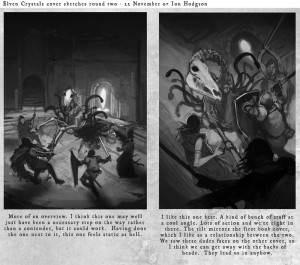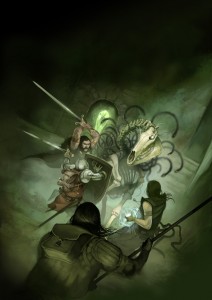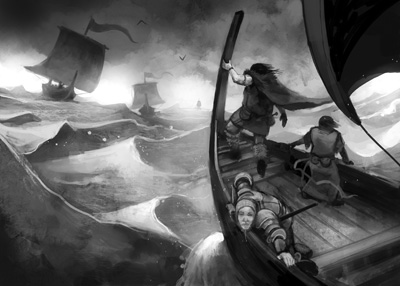So, what am I doing, getting together with Gar and Jon to set up a new publishing house to publish… Dragon Warriors? Of all things? Shouldn’t I be, you know, writing for WotC by now, or at least printing Pathfinder-compatible homebrew material? Why take on the licence for a game that was out of print for 20-odd years till very recently?
The answer is going to get a bit rambling and self-indulgent, I fear, but I’ll try to keep it entertaining.
Let me take you back to 1985. I was 15 years old, and had been playing D&D for 3 years (I actually started with Gamma World, and still love post-apocalyptic settings with mutants and Ancient Technology and craziness, but that is probably another story). Mostly I played at school, with my schoolmates. Pretty much every breaktime or lunchtime we gathered and carried on the game. Usually we’d just go through whichever TSR module I’d bought from Games of Liverpool (one of the then stalwarts of the British gaming scene as a retailer, importer, distributor, and even occasional publisher, now long forgotten and long-since eclipsed by their former rivals Games Workshop). To begin with, we played the red box Basic D&D, along with Expert D&D, but it soon became apparent that there were a lot more modules available for AD&D, and, well, there was just something of a cachet to being able to say one was an “Advanced” gamer, and having those big hardback books that looked like eldritch tomes rather than kids’ stuff. Still, though, I suspect the main driving force for the switch was the need for more adventure material. Sure, we were only playing for maybe 60-90 minutes a day, but that was five days a week.
The switch didn’t sit that well with us though. Those three thick hardback grimoires did look and feel amazing, but it was no fun carting them all to school every day. Plus, well, they were a mess, frankly. I know that’s a lot of the charm to some old-school fans — the fact that there’s no one overarching rule system to the things — but it was also no fun losing any of our precious minutes while I looked up some obscure rule. It felt, even then, that we had all this… bulk, this weight, this inertia to our games, that wasn’t actually adding a proportionate amount of fun. Then there was the setting. I had the World of Greyhawk, and I suppose we used it, roughly, but D&D was its own genre, and almost its own setting, even then, and despite the more mature look of the hardbacks, it was just as goofy as Basic D&D. I mean — Owlbears? “Hoo-hoo, hoo-hoo, hoo-hoo, ROAARRR!” Really? Even the orcs and goblins and hobgoblins and all the rest were a bit same-y; it already had the MMORPG vibe, where it seemed like the critters were mostly there so you could kill them and take their stuff, and the bigger, scarier critters were just that — bigger scarier versions of the littler ones, so when you’d levelled up you could fight them instead of the one-hit-die versions.
Of course, I’m writing this with the benefit of at least a little hindsight. I am not sure we were quite sophisticated enough to realise quite why AD&D was kinda goofy, even though we knew it was, and I am pretty sure we didn’t care that much; goofiness was part of its charm (and still is, I suppose). So was its focus on extrinsic rewards (XP, gold, levels, magic items) rather than intrinsic ones (interactivity, fun, peak experiences, gameplay, agency, the sense of triumph, etc.), but that’s for another PhD dissertation.
What we did know was that when Dragon Warriors came along, it was better: less goofy, more elegant, and (I’m sure this was a factor, too) way more portable. And, more than just “less goofy” — it absolutely dripped with British folklore. It made me think of A Company of Wolves, and old folktales, and King Arthur, and Robin Hood. Here was a game with a strong theme, a world and setting that was not only more familiar to us, more like our own than the hodgepodge of D&D, but also paradoxically more atmospheric, more otherworldly, too, because it was immersive and believable in a way that D&D rarely achieved.
Oh, for sure, it wasn’t perfect. You could play it with just Book 1, but if you wanted to play a magician, you needed Book 2, and though Sorcerers were fun, Mystics were more interesting — and yet Mystics had this annoying random quality, where they just weren’t useful enough once they’d become psychically fatigued… I guess I figured that if I ever got to write my own version, I’d try to fix that, at least.
It wasn’t perfect. But it was a breath of fresh air compared to D&D. I felt much the same way about RuneQuest, too, but most of my school-friends didn’t, so it was Dragon Warriors we stuck with, till we ran out of adventures, around the end of Book 3 (I don’t think I even found out about Books 4-6 till years later, but that’s for Part II).
After that… dammit, could we write anything that good? I didn’t think we could. And we didn’t have time. We had to buy more adventures for AD&D instead. Till we realised we could generate an all-evil party, of Anti-Paladins and Drow, get them all up to Level 26 using the Random Dungeon Table, and treat Deities & Demigods as our adventure for a bit, going through each pantheon and killing gods. Maybe we weren’t *that* much more sophisticated than all the other D&D-playing teenagers after all.



